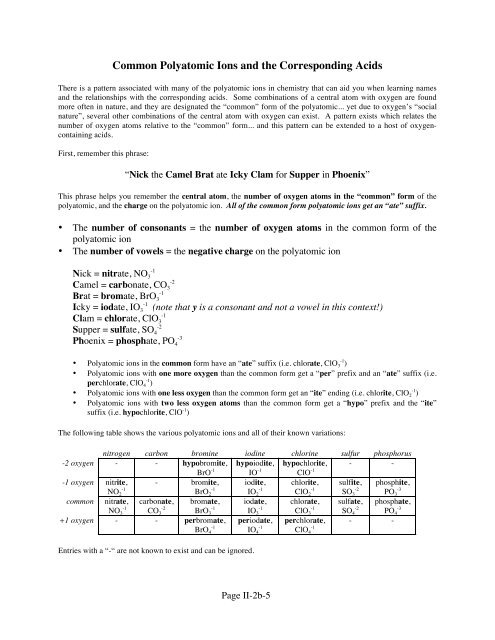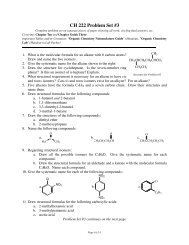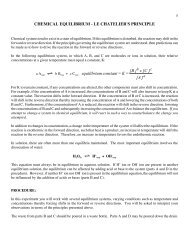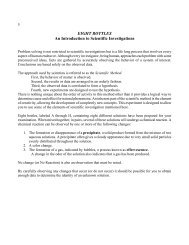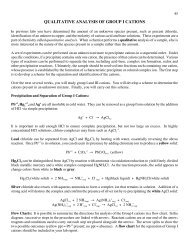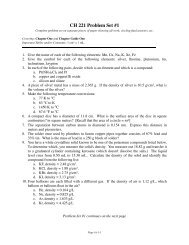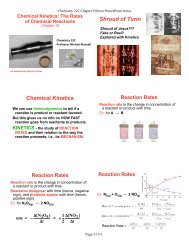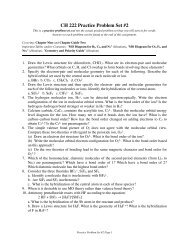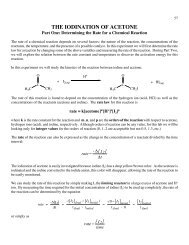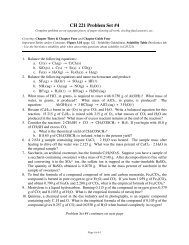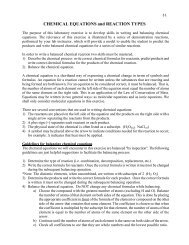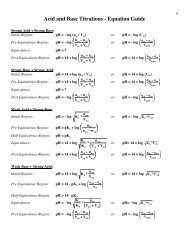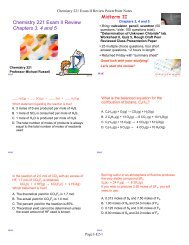Common Polyatomic Ions and the Corresponding Acids
Common Polyatomic Ions and the Corresponding Acids
Common Polyatomic Ions and the Corresponding Acids
You also want an ePaper? Increase the reach of your titles
YUMPU automatically turns print PDFs into web optimized ePapers that Google loves.
<strong>Common</strong> <strong>Polyatomic</strong> <strong>Ions</strong> <strong>and</strong> <strong>the</strong> <strong>Corresponding</strong> <strong>Acids</strong><br />
There is a pattern associated with many of <strong>the</strong> polyatomic ions in chemistry that can aid you when learning names<br />
<strong>and</strong> <strong>the</strong> relationships with <strong>the</strong> corresponding acids. Some combinations of a central atom with oxygen are found<br />
more often in nature, <strong>and</strong> <strong>the</strong>y are designated <strong>the</strong> “common” form of <strong>the</strong> polyatomic... yet due to oxygen’s “social<br />
nature”, several o<strong>the</strong>r combinations of <strong>the</strong> central atom with oxygen can exist. A pattern exists which relates <strong>the</strong><br />
number of oxygen atoms relative to <strong>the</strong> “common” form... <strong>and</strong> this pattern can be extended to a host of oxygencontaining<br />
acids.<br />
First, remember this phrase:<br />
“Nick <strong>the</strong> Camel Brat ate Icky Clam for Supper in Phoenix”<br />
This phrase helps you remember <strong>the</strong> central atom, <strong>the</strong> number of oxygen atoms in <strong>the</strong> “common” form of <strong>the</strong><br />
polyatomic, <strong>and</strong> <strong>the</strong> charge on <strong>the</strong> polyatomic ion. All of <strong>the</strong> common form polyatomic ions get an “ate” suffix.<br />
• The number of consonants = <strong>the</strong> number of oxygen atoms in <strong>the</strong> common form of <strong>the</strong><br />
polyatomic ion<br />
• The number of vowels = <strong>the</strong> negative charge on <strong>the</strong> polyatomic ion<br />
-1<br />
Nick = nitrate, NO3 -2<br />
Camel = carbonate, CO3 -1<br />
Brat = bromate, BrO3 -1<br />
Icky = iodate, IO3 (note that y is a consonant <strong>and</strong> not a vowel in this context!)<br />
-1<br />
Clam = chlorate, ClO3 -2<br />
Supper = sulfate, SO4 -3<br />
Phoenix = phosphate, PO4 • <strong>Polyatomic</strong> ions in <strong>the</strong> common form have an “ate” suffix (i.e. chlorate, ClO 3 -1 )<br />
• <strong>Polyatomic</strong> ions with one more oxygen than <strong>the</strong> common form get a “per” prefix <strong>and</strong> an “ate” suffix (i.e.<br />
perchlorate, ClO 4 -1 )<br />
• <strong>Polyatomic</strong> ions with one less oxygen than <strong>the</strong> common form get an “ite” ending (i.e. chlorite, ClO 2 -1 )<br />
• <strong>Polyatomic</strong> ions with two less oxygen atoms than <strong>the</strong> common form get a “hypo” prefix <strong>and</strong> <strong>the</strong> “ite”<br />
suffix (i.e. hypochlorite, ClO -1 )<br />
The following table shows <strong>the</strong> various polyatomic ions <strong>and</strong> all of <strong>the</strong>ir known variations:<br />
nitrogen carbon bromine iodine chlorine sulfur phosphorus<br />
-2 oxygen - - hypobromite, hypoiodite, hypochlorite, - -<br />
-1 oxygen nitrite,<br />
NO 2 -1<br />
common nitrate,<br />
NO 3 -1<br />
BrO -1<br />
- bromite,<br />
carbonate,<br />
CO 3 -2<br />
BrO 2 -1<br />
bromate,<br />
BrO 3 -1<br />
+1 oxygen - - perbromate,<br />
BrO 4 -1<br />
IO -1<br />
iodite,<br />
IO 2 -1<br />
iodate,<br />
IO 3 -1<br />
periodate,<br />
IO 4 -1<br />
Entries with a “-“ are not known to exist <strong>and</strong> can be ignored.<br />
Page II-2b-5<br />
ClO -1<br />
chlorite,<br />
ClO 2 -1<br />
chlorate,<br />
ClO 3 -1<br />
perchlorate,<br />
ClO 4 -1<br />
sulfite,<br />
SO 3 -2<br />
sulfate,<br />
SO 4 -2<br />
phosphite,<br />
PO 3 -3<br />
phosphate,<br />
PO 4 -3<br />
- -
<strong>Polyatomic</strong> ions readily make acids. An acid is a compound with a hydrogen atom that reacts readily with o<strong>the</strong>r<br />
substances. In chemistry, we list <strong>the</strong> acidic hydrogen first to designate its reactivity.<br />
As before, a naming pattern exists for acids containing an oxygenated polyatomic ion:<br />
• Acidic polyatomic ions in <strong>the</strong> common form have an “ic acid” suffix (i.e. chloric acid, HClO 3)<br />
• Acidic polyatomic ions with one more oxygen than <strong>the</strong> common form get a “per” prefix <strong>and</strong> an “ic acid”<br />
suffix (i.e. perchloric acid, HClO 4)<br />
• Acidic polyatomic ions with one less oxygen than <strong>the</strong> common form get an “ous acid” ending (i.e.<br />
chlorous acid, HClO 2)<br />
• Acidic polyatomic ions with two less oxygen atoms than <strong>the</strong> common form get a “hypo” prefix <strong>and</strong> <strong>the</strong><br />
“ous acid” suffix (i.e. hypochlorous acid, HClO)<br />
• Acidic polyatomic ions with no oxygen atoms get a “hydro” prefix <strong>and</strong> <strong>the</strong> “ic acid” suffix (i.e.<br />
hydrochloric acid, HCl)<br />
The following table shows <strong>the</strong> acidic form of <strong>the</strong> polyatomic ions with all of <strong>the</strong>ir known variations:<br />
nitrogen carbon bromine iodine chlorine sulfur phosphorus<br />
no oxygen - - hydrobromic hydroiodic hydrochloric hydrosulfuric -<br />
acid, HBr acid, HI acid, HCl acid, H2S -2 oxygen - - hypobromous hypoiodous hypochlorous - -<br />
acid, HBrO acid, HIO acid, HClO<br />
-1 oxygen nitrous - bromous iodous chlorous sulfurous phosphorous<br />
acid,<br />
acid, HBrO2 acid, HIO2 acid, HClO2 acid, H2SO3 acid, H3PO3 HNO 2<br />
common nitric<br />
acid,<br />
HNO 3<br />
carbonic<br />
acid,<br />
H 2CO 3<br />
bromic acid,<br />
HBrO 3<br />
+1 oxygen - - perbromic<br />
acid, HBrO 4<br />
iodic acid,<br />
HIO 3<br />
periodic<br />
acid, HIO 4<br />
Page II-2b-6<br />
chloric acid,<br />
HClO 3<br />
perchloric<br />
acid, HClO 4<br />
sulfuric acid,<br />
H 2SO 4<br />
phosphoric<br />
acid, H 3PO 4<br />
- -<br />
Finally, please note that this list is not 100% inclusive... but similar patterns can be applied to polyatomic ions not<br />
on this list. For example,<br />
• H2SeO4 = selenic acid <strong>and</strong> H2SeO3 = selenous acid<br />
-3 -3<br />
• AsO4 = arsenate ion <strong>and</strong> AsO3 = arsenite ion


